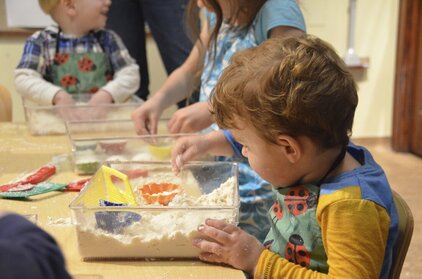 Occupational therapy can help to improve a child’s motor, cognitive, sensory processing, communication, and play skills. The goal of pediatric OT is to enhance development, minimize the potential for developmental delay, and help families to meet the special needs of their infants, toddlers and school-age children. Understanding child development delays The first three years of any child’s life are a critical time for brain development. During this busy period of cognitive, social and physical growth, children learn so much about how to interact with the millions of new stimuli occurring each and every day of their lives. From learning to crawl, walk, speak, listen, grasp, self-feed, self-dress, and how to play with toys, children are tasked with learning a lot in a very short time and they are constantly absorbing how to appropriately interact physically, emotionally and verbally with the world around them. Children who may be experiencing subtle-to-severe cognitive, social or physical delays will usually begin showing signs of these at any point between the ages of 0-4. If a child’s developmental delays are more subtle and nuanced, a pediatrician or infant and toddlers specialist may recommend a thorough battery of evaluations that includes an occupational therapy screening for concerned parents and caregivers. Why is an OT evaluation recommended? Occupational therapy is intended to treat a variety of problems associated with conditions resulting from birth injuries or defects, sensory processing disorders, traumatic brain or spine injuries, learning disabilities, autism, rheumatoid arthritis, mental or behavioral problems, orthopedic injuries, post-surgical conditions, injuries, and other chronic illnesses. An occupational therapy (OT) evaluation is one that is completed by a licensed occupational therapist (OTL/R) to assess a child's gross motor, fine motor, visual motor, visual perceptual, handwriting, daily living and sensory processing skills. OT professionals use a group of standardized assessment tools, non-standardized assessment tools, parent interview and clinical observations to assess a child's performance. The results of a formal OT evolution can help better determine things like how well a child’s hands work together, if the child processes what he sees, hears, feels, etc. and produces an appropriate response and even if the child is able to calm themselves or adapts to their environment. These types of sensory integrative issues can exacerbate the child’s development and be a reason for observed delays. What to expect at an OT evaluation The occupational therapist performing an evaluation on a child will determine a baseline for abilities and then perform play-based evaluations that include both standardized and clinical observations with the child performing functional skills. These vary by provider, but might include screening ball play, fine motor play, visual motor tasks, visual perception skills, gross motor tasks, self-care skills (eating, getting dressed), social interaction and visual processing skills. Once assessments are completed, the OT will summarize all information gathered and present the clinical impressions and recommended treatment goals that will best address any identified concerns. Often, this report will a time frame for the recommended treatment plan before a reassessment is warranted. If routine occupational therapy is recommended, the length of time and expectations will vary based on your child’s individualized therapeutic goals. How OT helps young learners A child who may be exhibiting delays with developing fine motor skills – i.e. those involving the small hand muscles – can work with an OT to improve strength, motor control and dexterity. Without these skills, kids will have difficulty drawing, using scissors and stringing beads. These types of delays are detrimental, especially for elementary academics, because seemingly easy tasks like turning pages, writing, using a computer, may be that much harder. Occupational therapists help children by working closely with them to learn skills that will foster independence and enable participation in daily activities, such as self-care, play and learning. An occupational therapist can also help to establish effective routines and break down information into steps that the child with delays will be able to follow. Occupational therapists can also help children diagnosed with sensory issues. For example, hypersensitive children (those prone to feeling “sensory overload”) can learn to better self-regulate in uncomfortable environments or advocate for themselves when they need beaks or quiet accommodations to learn. To help sensory seekers (those who seek a higher level of sensory arousal and regulation), OTs focus on teaching them ways to self-regulate using activities like swinging, crashing onto huge bean bags, and jumping on trampolines in areas known as “sensory gyms.” Learning these skills and practicing them at regular intervals can help children be able to sit and focus when it’s time to learn. Gross motor developmental delays can be addressed by the OT using exercises and activities to promote balance, coordination, strength, and endurance. These skills have a direct impact on how children walk, run, go up stairs, jumping, catching and other skills that will enable them to successfully participate in sports and recess activities – which are crucial elements for building social emotional strengths and self-esteem. How to get an OT evaluation While medical coverage may vary, many health insurance plans cover occupational therapy evaluations and services. Kinera Foundation provides occupational therapy (OT) services for children, teens and adults with disabilities and special health care needs. If you are concerned about your child's development, or your child is showing signs of or has been diagnosed with a sensory processing issues, please call for a confidential meeting and evaluation: 443-249-3126.
7 Comments
 Assistive technology is just one of the many expenses covered by the LISS grant Assistive technology is just one of the many expenses covered by the LISS grant Children and adults living with developmental disabilities, who are not getting support from the Developmental Disabilities Administration, can still obtain equal access to funding opportunities through a program called Low Intensity Support Services (LISS). LISS strives to give families with children or adults who live in their own home happy, healthy and independent lives while being included members of their community. The LISS grant provides up to $2000 for services and items to fulfill the needs of growing children and maturing adults. It also promotes community integration and independence in order to help improve the quality of life for eligible children and adults. The 2020 deadline to apply for a LISS grant is Nov. 23 and the online application process takes approximately just 2-minutes-or-less to complete. Some examples of items/services that may be purchased with LISS funds include: Assistive Technology Attendant care Barrier Removal Camp (youth & adult) Childcare Daycare Employment-related services Health services Housing Adaptations Identification services Individual and Family Counseling Medical equipment purchase, rental, and repair Personal Care Respite Specialized equipment Therapeutic Services Training and support for self-advocacy Transportation assistance Adaptive Equipment Tuition for post-secondary academic / vocational To guarantee equality in these opportunities, the LISS program uses a random selection process in order to choose from the applicants. A quick, easy application is all that's needed in order to apply. LISS grant application and eligibility To be eligible, one must live in Maryland and have a developmental disability that can be physical or mental. Some determining factors are that it will most likely continue forever, it started before the age of 22 and support and assistance is needed to help with services and treatments. To apply now, please complete this online application form found on the Maryland Department of Health website. There are two rounds of applications each year. For another chance, the next round is usually in the spring. Not everyone who applies for the grant will receive funding as funding amounts are limited each year. On top of this opportunity, the Kinera Foundation is always here to help support families through parent to parent support and innovative programs to help transitioning children and adults. Please contact [email protected] if you have questions about the LISS grant or application and selection process.  Understanding Epilepsy Epilepsy is a neurological condition that affects the nervous system. Epilepsy is also known as a "seizure disorder." It is usually diagnosed after a person has had at least two seizures (or after one seizure with a high risk for more) that were not caused by some known medical condition. Is estimated that nearly 65 million people worldwide currently live with epilepsy, which can affect any person at any age in their lifetime. New cases of epilepsy are more commonly diagnosed children and usually within the first year of their life. According to the Epilepsy Foundation, 1-in-10 people will experience a seizure throughout their life, and 1-in-26 will develop epilepsy. Epilepsy is a relatively common disorder, but there is very little understanding in the grand scheme of things. Though there are treatments and medications available to patients diagnosed with epilepsy , a person will live with the condition forever. The goal of medicine is to decrease the frequency of seizures. Seizure First Aid Knowing how to respond in the event that someone has a seizure is just as important as knowing CPR. Seizures occur when abnormal electric signals from the brain change the way the body functions. There are many different types of seizures, which may cause anything from convulsions, muscle spasms, brief or prolonged loss of consciousness, strange sensations and emotions, and/or abnormal behaviors. Seizures can be triggered by an isolated incident such as high fever, infection, exposure to toxin, and metabolic abnormalities like hypoglycemia, but are frequently evidence of an underlying medical condition. Seeing someone collapse and seize can be frightening, but there are simple steps to take to provide a safer environment when it happens. For most seizures, basic seizure first aid is all that is needed. The steps are simple - Stay. Safe. Side. To the following organizations are great resources for families looking to get more information about epilepsy.
Epilepsy Foundation: https://epilepsywdc.org/ Cure Epilepsy: http://www.cureepilepsy.org/ International League Against Epilepsy https:www.ilae.org/ |
AuthorWrite something about yourself. No need to be fancy, just an overview. Archives
June 2022
Categories
All
|
|
Kinera Foundation
115 Sallitt Dr., Suite C Stevensville, MD 21666 (Chesapeake Bay Business Park) Phone: 443-249-3126 Fax: 443-458-0446 Kinera Foundation is a 501(c)(3) Nonprofit organization |
|
Copyright © 2024
Kinera Foundation, Inc. All rights reserved |
|
|
|
